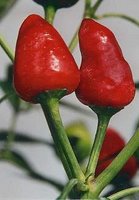What is the hottest chile pepper?
 I sniffed around the Web, taking little bites of information from various sites. Eventually, I came up with what we hope is a satisfactory answer, although there are some Indian scientists out there who might argue with my conclusion.
I sniffed around the Web, taking little bites of information from various sites. Eventually, I came up with what we hope is a satisfactory answer, although there are some Indian scientists out there who might argue with my conclusion.Chile peppers are measured in Scoville Heat Units, named after pharmacist Wilbur Scoville who invented a scale to measure the heat of peppers. Each unit is actually a measure of capsaicin (the chemical responsible for a pepper's heat).
I found several sources that claimed a 1994 red savina habañero from GNS Spices was the hottest pepper ever tested, measuring in at an amazing 577,000 Scoville Units! However, scientists in India claim they grew the hottest chile in the world in the northeastern hills of Assam, a variety called Naga Jolokia. This pepper was tested and found to have 855,000 Scoville Units, though the methods used have been called into question.
I went to the home page of Fiery-Foods.com and found my way to a heat scale. The scale was compiled by Dave DeWitt, the site's creator, with the help of Dr. Ben Villalon of the Texas Agricultural Experiment Station and Dr. Paul W. Bosland of New Mexico State University's Department of Agronomy and Horticulture. They claim it's the most up-to-date chart around.
Many factors affect the Scoville Unit measurement of a pepper, including the genetic background of the plant, the soil it's grown in, the temperature, the fertilizer used, and the watering practices. The various charts and scales should not be considered definitive heat levels for particular varieties. It's quite possible to pick up a few jalapeños at the local market and have one be mild and another be
rip-roaring hot.
Receive post updates by Email



























 Add my feed to your Rss
Add my feed to your Rss
